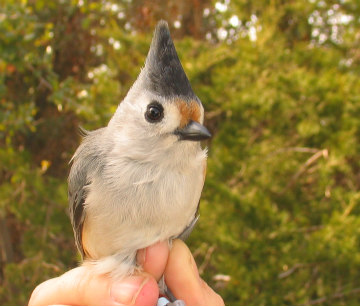 Photo ©
Claire Curry
Photo ©
Claire Curry
Hybrid Titmouse Nesting Success
Four years ago, we reported on a hybridization study undertaken by Ph.D. candidate Claire Curry. This month, we are happy to bring you a research update from Dr. Curry’s recently-published paper.
Where two closely-related species overlap in range, there is the potential for them to interbreed and form hybrids. Sometimes species hybridize (e.g., Black-capped and Carolina chickadees), but sometimes they don’t (e.g., American and Fish crows). Why? Claire and her colleagues set out to address this question using the Black-crested and Tufted titmouse hybrid zones in Texas and Oklahoma.
Using data from 195 nests submitted by NestWatchers in the Texas hybrid zone, Claire investigated whether there were any differences in nesting success of Black-crested, Tufted, or hybrid titmice. Hybrids of many species tend to have lower nesting success, but Claire found no differences in clutch size, brood size, or nesting success among the three types. This suggests that poor reproductive fitness is not the reason that Black-crested and Tufted titmice remain separate populations.
Claire’s research also investigated behavior, such as preference for song and plumage types, which show more promise in figuring out where these two distinct populations may diverge from each other. According to Claire, “The NestWatch data provided a useful view of the status of hybrid reproductive fitness. More data are needed from the Oklahoma hybrid zone, where the lack of NestWatchers makes understanding their nesting success in this area difficulty to study.”
 Photo ©
Photo ©